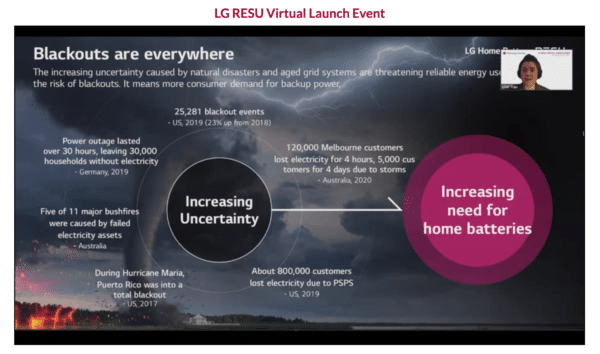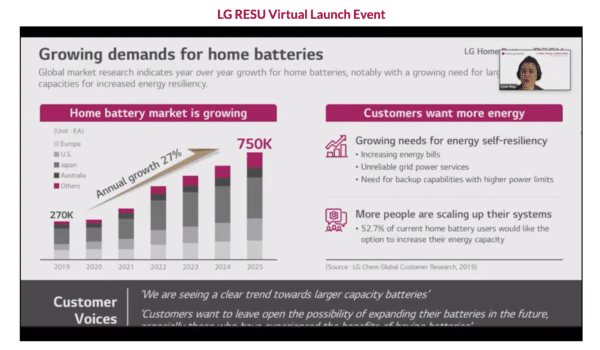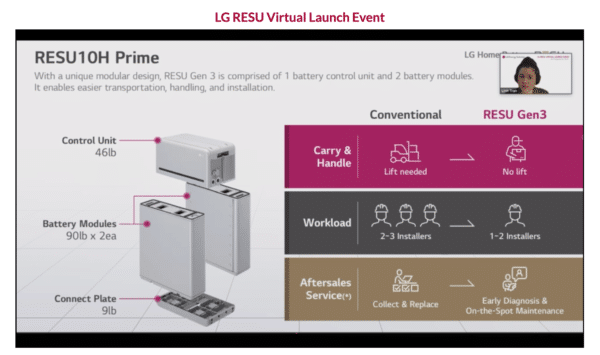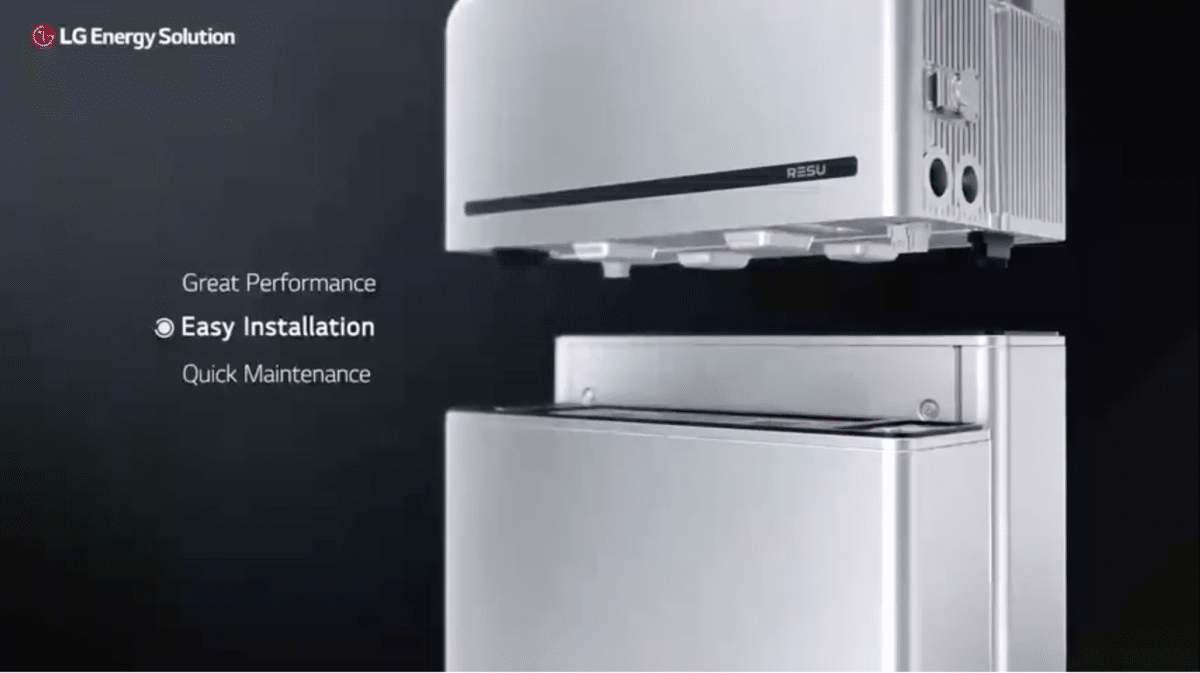In September, pv magazine’s Jonathan Gifford wrote, “in most Aussie homes using the electrons generated on the rooftop in the home – via a battery, simply doesn’t pay” and that is still the case at the end of this tumultuous year, despite ongoing falls in battery prices. But LG Energy Solutions has just launched what it claims is the industry’s largest home battery — LG RESU16H Prime 16 kWh battery pack with high power of 7 kW and peak power of 11 kW — and its sister LGRESU10H, on the premise that they afford homeowners resilience against the increasing incidence of blackout due to bushfire, extreme weather or grid instability.
During Covid-19, said Linh Tran, Director of Sales for LG Energy Solution in North America, “We’ve worked from home, educated our children from home, and our livelihoods are attached to how much time we’re spending in our homes. The need to have backup power during times when it’s become more common to have outages is more severe. We have more to lose now if there’s a power outage than ever before.”

Image: LG Energy Solution
Whether the economic argument for installing batteries has shifted into the black or not, the resilience argument seems to have shifted due to the threat of blackout.
LG Chem, the Korean chemical company that has become one of the world’s largest manufacturers of lithium-ion batteries of all kinds, this month put its energy storage system eggs into a separate share market basket, spinning off its battery business as LG Energy Solution.
The move was described by The Korea Times as designed to “prevent its debt-financed investments in its electric vehicle (EV) battery business from affecting the company’s petrochemical business, as well as to secure additional capital for further battery sector expansion.”
At Friday’s virtual launch of the company’s third-generation RESU battery products, Youngjoon Shin, Senior Vice President of ESS Business at LG Energy Solution, said the newly launched entity, which started in the ESS business in 2010 “is set to become the most important of the lot” of LG Chem companies, “as it makes a sustainable future in a connected society possible”.

Image: LG Energy Solution
The potential is for a dual
Both new LG RESU batteries have a modular design which allows them to be doubled up: the LG RESU16H Prime, with a depth of discharge that provides 16kWh of useable energy, can be scaled to 32 kWh, with 14 kW of power; while the LG RESU10H, which offers 9.6 kWh of useable energy can be doubled to 19.2 kWh with 10 kW of power.
Another aspect of the series’ modularity is that the battery stacks of lithium cells are separately packaged from the power electronics.
“As we all know,” said Tran, “power electronics is where most of your issues are going to happen, and now you can just pop the top and replace it”, providing a “much more field serviceable unit” because “the heavy stuff”, the lithium, can stay where it is.
In addition, remote battery monitoring provides real-time status reports and early diagnosis of problems. Tran said the RESU monitor will have both a web-based user interface for homeowners and an app for installers that provides a separate line of sight into the battery outside of the inverter. She added that primarily the monitoring will help reduce site visits and the overall cost of maintaining the system.

Image: LG Energy Solution
Long-life capacity
The new series also comes with an extended battery life, warranted for 70% capacity retention after 10 years of use; and compatible inverters include SMA, SolarEdge, Sungrow, GoodWe and Solis.
The RESU16H Prime is floor mounted, while the RESU10H Prime can be floor or wall mounted, and both units are certified IP55 for indoor or outdoor installation.
The smaller system is available in Australia this year, while prospective buyers can ponder the value offered by the RSU16H for a few months — it’s scheduled to arrive some time in March 2021. Philip Crotty, General Manager of LG Energy Solutions in Australia, said “it will land with Clean Energy Council approval”.
What’s next for the new LG entity?
As part of Friday’s virtual launch, LG Energy Solution also previewed its RESU Flex modular system, scheduled for release in the second half of 2021, but with no fixed arrival in Australia as yet.
Up to four RESU Flex battery units of 8.6~17.2 kWh capacity, and with rated power of 4.3~8.5 kW and 5~11 kW peak, can be connected in different ways to offer optimised capacity for the needs of large households or for small businesses.
In line with its proposed use, the system will be compatible with both single-phase and three-phase inverters.
“But what’s really neat about it is this modular capability,” said Tran, showing four battery modules served by a single control unit. “You have multiple energy capacities and multiple core factor configurations and it becomes a showpiece — showcasing your renewable energy,” she said.
The shifting value proposition
Beauty is in the eye of the purchaser, and for many it may continue to centre around savings before flagrant energy independence.
Pricing has not yet been revealed on the new-generation LG RESU series, but increased performance throughout the battery life, as well capacity and flexibility — even in the RESU Prime range — will factor in to buyer decision making.
In natural-disaster-prone areas, off-grid applications, and situations where the buyer’s home has become more than their castle, the value will stack up differently again.
This content is protected by copyright and may not be reused. If you want to cooperate with us and would like to reuse some of our content, please contact: editors@pv-magazine.com.









2 comments
By submitting this form you agree to pv magazine using your data for the purposes of publishing your comment.
Your personal data will only be disclosed or otherwise transmitted to third parties for the purposes of spam filtering or if this is necessary for technical maintenance of the website. Any other transfer to third parties will not take place unless this is justified on the basis of applicable data protection regulations or if pv magazine is legally obliged to do so.
You may revoke this consent at any time with effect for the future, in which case your personal data will be deleted immediately. Otherwise, your data will be deleted if pv magazine has processed your request or the purpose of data storage is fulfilled.
Further information on data privacy can be found in our Data Protection Policy.